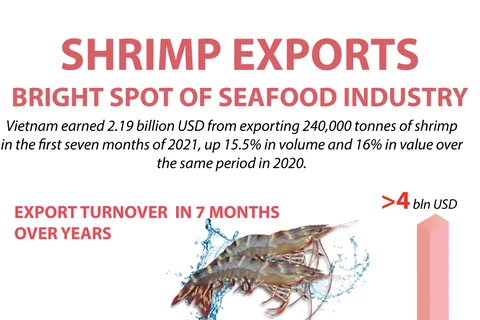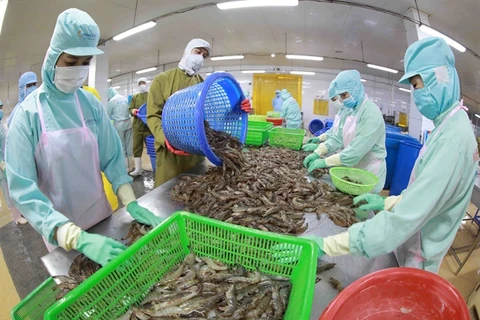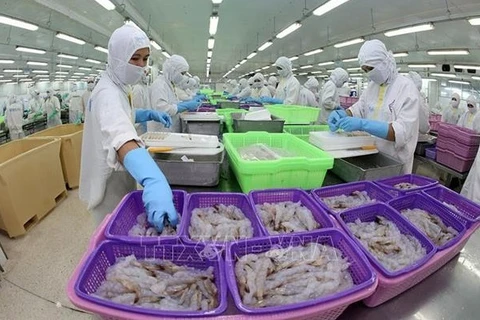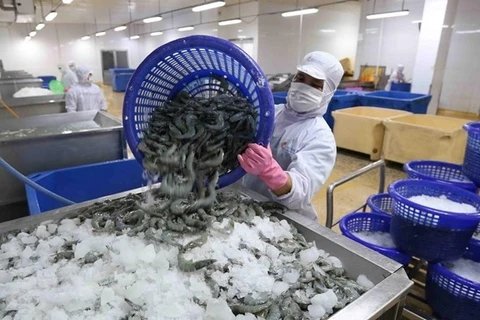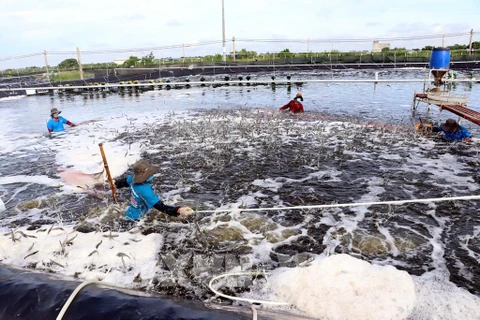Hanoi (VNA) – There are now many favourable conditions for shrimp export, including growing prices - an important factor for processors and exporters to swiftly recover after a long social distancing period.
Deputy Minister of Agriculture and Rural Development Phung Duc Tien made the remark while addressing a teleconference held on December 10.
He said the free trade agreements that Vietnam has joined will create chances for improving production under value chains and origin traceability.
Productivity and quality are the key to promoting the competitiveness of shrimp products, Tien noted, adding that relevant agencies and localities needs to pay attention to the input, especially young fry and infrastructure in the production chain.
Tran Cong Khoi, Deputy Director of the Department of Aquaculture at the Directorate of Fisheries, said despite numerous difficulties and challenges caused by the COVID-19 pandemic, this year’s farming area of brackish water shrimp still expanded by 0.5 percent from 2020 to 740,000ha, including 630,000ha of black tiger shrimp and 110,000ha of white-leg shrimp.
Pointing out certain problems and shortcomings, he held that localities need to step up inspection and examination of food safety in aquaculture to ensure product quality.
In 2022, the sector will enhance connectivity among shrimp farming localities, take measures to concurrently develop farming and cope with the pandemic, boost the application of scientific and technological advances to raise productivity and quality, and increase environmental monitoring to issue timely warnings in order to minimise damage caused by climate change.
Deputy Minister of Agriculture and Rural Development Phung Duc Tien made the remark while addressing a teleconference held on December 10.
He said the free trade agreements that Vietnam has joined will create chances for improving production under value chains and origin traceability.
Productivity and quality are the key to promoting the competitiveness of shrimp products, Tien noted, adding that relevant agencies and localities needs to pay attention to the input, especially young fry and infrastructure in the production chain.
Tran Cong Khoi, Deputy Director of the Department of Aquaculture at the Directorate of Fisheries, said despite numerous difficulties and challenges caused by the COVID-19 pandemic, this year’s farming area of brackish water shrimp still expanded by 0.5 percent from 2020 to 740,000ha, including 630,000ha of black tiger shrimp and 110,000ha of white-leg shrimp.
Pointing out certain problems and shortcomings, he held that localities need to step up inspection and examination of food safety in aquaculture to ensure product quality.
In 2022, the sector will enhance connectivity among shrimp farming localities, take measures to concurrently develop farming and cope with the pandemic, boost the application of scientific and technological advances to raise productivity and quality, and increase environmental monitoring to issue timely warnings in order to minimise damage caused by climate change.
Total output of farmed shrimp this year is estimated at 970,000 tonnes, up 4.3 percent from 2020. Shrimp export earned the country 3.2 billion USD in the first 10 months of this year, a year-on-year increase of 2 percent./.
VNA

